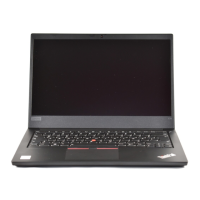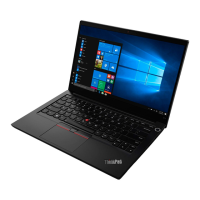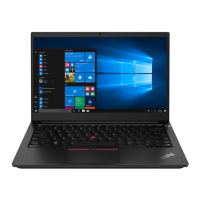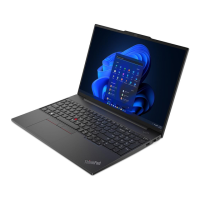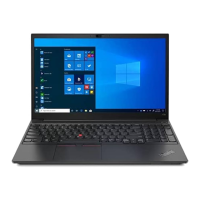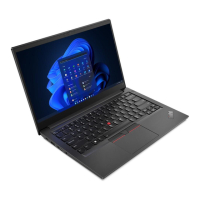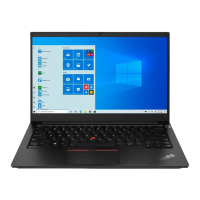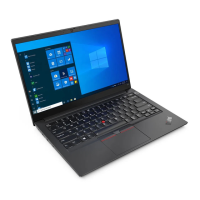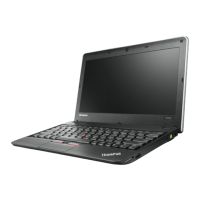Do you have a question about the Lenovo ThinkPad E15 and is the answer not in the manual?
Details the components visible on the front of the computer, including microphones and camera.
Identifies and describes components located on the base of the E14/R14/S3 Gen 2 models.
Explains how to use the power button and interpret its indicator light status.
Instructions for using the fingerprint reader for login and its indicator light.
Describes the USB-C and Always On USB connectors on the left side of the computer.
Explains the function and capabilities of the USB 3.2 Gen 1 connector.
Describes the use of the High-Definition Multimedia Interface (HDMI) connector.
Explains how to connect headphones or headsets using the audio connector.
Details the USB 2.0 connector, Ethernet connector, and security-lock slot.
Explains how to connect USB-compatible devices using the USB 2.0 port.
Describes how to connect to a local area network (LAN) using the Ethernet port.
Explains how to secure the computer using a security cable lock.
Provides detailed specifications for dimensions, power, processor, memory, display, keyboard, and connectors.
Lists security features like fingerprint reader, password, and TPM.
Details wireless connectivity options such as Bluetooth and Wireless LAN.
Lists other components like Camera and Microphones.
Explains factors affecting USB transfer rates and lists data rates for different USB versions.
Introduces the basics of Windows 10 and how to start using it.
Explains the requirement for user accounts and the types available (Windows/Microsoft).
Identifies and explains key elements of the Windows 10 user interface.
Instructions on how to open the Start menu using the button or Windows key.
How to navigate to the Control Panel from the Start menu.
Information about Genuine Microsoft labels and their meaning.
Guides on connecting to wired Ethernet and wireless Wi-Fi networks.
Steps to connect Bluetooth-enabled devices like keyboards and mice.
Explains the purpose and key features of the Lenovo Vantage application.
Overview of different ways to navigate and interact with the computer's interface.
Details special keys and keyboard shortcuts for easier operation.
Opens the Start menu.
Switches letter case between upper and lower case.
Invokes special functions or standard functions printed on keys.
Input numbers quickly when the Numeric Lock indicator is on.
Explains switching between standard and special functions using Fn key.
Details keys for speaker, volume, display brightness, and external displays.
Explains keys for wireless features, settings, and Bluetooth.
Details keys for calculator, sleep mode, Snipping Tool, and keyboard backlight.
Explains how to use the TrackPoint pointing stick and its buttons for navigation.
How to use the pointing stick for cursor movement.
Press to select or open an item.
Press to display a shortcut menu.
Used for scrolling with the pointing stick.
Instructions on how to disable the TrackPoint pointing device via settings.
Explains how to use the trackpad for pointing, clicking, and scrolling.
How to perform a left-click action on the trackpad.
How to display a shortcut menu using the trackpad.
Details various touch gestures for trackpad operation like tap, scroll, and zoom.
Tap with one finger to select or open an item.
Tap with two fingers to display a shortcut menu.
Scroll documents, web pages, or apps vertically or horizontally.
Zoom in or out on content using two fingers.
Details three-finger swipe gestures for task view and desktop display.
Instructions on how to disable the trackpad via settings.
Information on using built-in camera, speakers, and audio features.
How to connect audio devices and change sound settings.
Instructions for using the camera to take photos or record videos.
Guides on connecting to wired and wireless external displays.
Steps to connect to projectors or monitors via HDMI or USB-C.
Instructions for connecting to a wireless display using Miracast.
How to choose display modes like Duplicate, Extend, or Show only on one display.
How to adjust display settings like resolution and orientation.
Information on managing power, battery status, temperature, and charging.
How to check the battery status icon and temperature details.
Details on charging the computer using AC power and the P-to-P 2.0 function.
How to use the USB-C port to charge other computers.
Tips and actions to extend the battery life of the computer.
How to define what the power button does (e.g., shut down, sleep).
How to choose or customize a power plan for optimal performance and energy saving.
How to enable or disable Airplane mode to turn off wireless features.
Information about purchasing accessories and upgrades for the computer.
Instructions on how to lock the computer to a desk using a security cable.
Introduces password types in UEFI BIOS and how to manage them.
Details power-on, supervisor, system management, and hard disk passwords.
Explains the system management password and its authority.
Describes user and master hard disk passwords for data access protection.
Step-by-step guide for setting, changing, and removing UEFI BIOS passwords.
Procedure to remove the power-on password if forgotten.
Information on what to do if hard disk passwords are forgotten.
Guidance on what to do if the supervisor password is forgotten.
Procedure to remove the system management password if forgotten.
How to enroll fingerprints and log in to Windows using the reader.
Information about the preinstalled firewall and antivirus software.
Introduction to UEFI BIOS, its functions, and how to access it.
Step-by-step guide to enter the UEFI BIOS setup menu.
Explains keys used to navigate and interact within the UEFI BIOS interface.
How to set the boot device order in the UEFI BIOS.
Procedure to set the system date and time within the UEFI BIOS.
Methods to download and install the latest UEFI BIOS update.
Guides on system restore options and creating recovery media.
How to use System Restore to revert to an earlier state.
Steps to restore personal files using the File History tool.
Instructions on how to reset the computer to its original state.
How to access advanced startup options for recovery.
Explains how Windows recovery environment operates automatically.
Guide to creating and using a USB drive for system recovery.
Instructions for installing the operating system and device drivers.
Detailed steps for installing Windows 10, including security chip and Optane memory setup.
Methods to download and install the latest drivers for optimal performance.
Defines self-service and optional-service CRUs.
Instructions to disable Fast Startup and the built-in battery before CRU replacement.
Procedure for removing and replacing the base cover assembly.
General steps to follow when replacing a CRU.
Step-by-step guide to remove and replace the base cover assembly.
Procedure for replacing the memory module.
Safety and handling precautions before replacing the memory module.
Procedure for replacing the internal storage drive (HDD/SSD).
Safety and data backup instructions before replacing the storage drive.
Procedure for replacing the M.2 solid-state drive.
Safety and handling precautions before replacing the M.2 SSD.
Procedure for removing and replacing the speaker assembly.
Safety and handling precautions before replacing the speaker assembly.
Answers common questions about accessing features and troubleshooting issues.
Lists common error messages and their corresponding solutions.
Provides solutions for specific error messages like low battery and system security.
How to use Lenovo SmartBeep technology to decode beep errors.
Lists resources like Lenovo Vantage, product documentation, and web support.
How to access Lenovo Vantage and product documentation for support.
Accessing drivers, software, and knowledge base on the Lenovo support site.
Using Windows help and Microsoft support resources.
Information on how and when to contact Lenovo Customer Support.
Information to record before contacting Lenovo support.
Telephone numbers and services available during and after the warranty period.
Details services like problem determination and hardware repair.
Lists services that are not covered by the warranty.
Information on purchasing extended warranty and other services.
General safety information to help use the computer safely and reduce risks.
Tips for safe computer use to prevent discomfort, injury, or failure.
Precautions to avoid burns from hot computer parts.
Precautions to avoid burns from the AC power adapter.
Advice to keep liquids away from the computer to avoid spills and shock.
How to route cables to prevent damage or tripping hazards.
Steps to protect the computer and data when moving it.
Precautions to avoid dropping, bumping, or scratching the computer.
Tips for using a carrying case and packing the computer.
What to do if you notice smoke, sparks, unusual sounds, or other hazards.
Information on self-service, approved providers, and safety during service.
Safety warnings and guidelines for using power cords and adapters.
Ensuring extension cords and related devices are properly rated.
Safety guidelines for using plugs, outlets, and preventing electrical hazards.
Warning about not removing power supply covers due to hazardous voltage.
Caution about connecting/disconnecting devices while the computer is on.
Dangers of battery abuse, mishandling, and proper storage/disposal.
Warning against replacing built-in batteries and recharge instructions.
Danger of explosion if lithium coin-cell battery is replaced incorrectly.
Precautions regarding heat generation and ensuring proper ventilation.
Safety hazards related to electric current and precautions for connecting/disconnecting cables.
Caution regarding handling the LCD screen and mercury content.
Warnings about excessive sound pressure and hearing loss.
Warning about small parts and choking hazards for young children.
Warning about plastic bags and suffocation risk for babies and children.
Caution about glass parts breaking and not touching broken glass.
Precautions to prevent static electricity damage to components.
Specifies maximum altitude, temperature, and humidity ranges.
Topics on keeping the computer clean for best performance.
Tips for proper placement, care, and handling of the computer.
Instructions for cleaning the computer cover, keyboard, and screen.
Lenovo's commitment to accessibility and resources for users with limitations.
Lists keyboard shortcuts to aid in computer navigation and use.
How to access and use tools like Magnifier, Narrator, and On-Screen Keyboard.
How to use High Contrast for better text and image visibility.
Adjusting keyboard settings for easier use and pointer control.
Adjusting mouse settings for pointer appearance and window management.
Using voice commands to control the computer and perform tasks.
Information about screen readers and PDFs for accessibility.
How to adjust screen resolution for better readability.
Changing item size temporarily or permanently for screen readability.
Notes that the computer provides industry-standard connectors for assistive devices.
Lenovo provides documentation in accessible formats like tagged PDFs and HTML.
Importance of ergonomics, workplace arrangement, and healthy work habits.
Tips for maintaining good posture to prevent discomfort during work.
Advice on display viewing distance, glare, and brightness adjustment.
Guidance on maintaining a comfortable and neutral head position.
Advice on choosing a chair for good back support and height adjustment.
Tips for relaxed and neutral arm and hand posture while typing.
Guidance on keeping thighs parallel to the floor and feet flat.
Tips for maintaining comfort and performance when working on the move.
Advice on eye fatigue and consulting a vision-care specialist.
Statements regarding compliance with RF and safety standards.
Details on wireless interoperability and usage environment.
Information on RF safety standards and restricted wireless use environments.
Shows the locations of the wireless LAN antennas on the computer.
Where to find wireless regulatory notices for your region.
Product conformity with EU Council Radio Equipment Directive 2014/53/EU.
Statement regarding interference protection for Brazil.
FCC Supplier's Declaration of Conformity for Class B equipment.
How to find FCC and IC certification details on the computer.
Compliance statement for Industry Canada.
Product conformity with the EMC Directive 2014/30/EU.
Statement regarding German EMC compliance for Class B equipment.
Statement regarding Japan VCCI Class B compliance.
Statement on harmonic current regulation for products connecting to power mains.
Notice regarding the use of the shipped AC power cord.
Provides other compliance information for various countries and regions.
Precautions for vision health related to screen use.
Details for the Eurasian Union: manufacturer, importer, and contact info.
Notice about potential hearing damage from loud sounds.
Information about ENERGY STAR certified computers and energy efficiency.
Information on product availability, patents, and document changes.
Lists trademarks associated with Lenovo and other companies.
Details the components visible on the front of the computer, including microphones and camera.
Identifies and describes components located on the base of the E14/R14/S3 Gen 2 models.
Explains how to use the power button and interpret its indicator light status.
Instructions for using the fingerprint reader for login and its indicator light.
Describes the USB-C and Always On USB connectors on the left side of the computer.
Explains the function and capabilities of the USB 3.2 Gen 1 connector.
Describes the use of the High-Definition Multimedia Interface (HDMI) connector.
Explains how to connect headphones or headsets using the audio connector.
Details the USB 2.0 connector, Ethernet connector, and security-lock slot.
Explains how to connect USB-compatible devices using the USB 2.0 port.
Describes how to connect to a local area network (LAN) using the Ethernet port.
Explains how to secure the computer using a security cable lock.
Provides detailed specifications for dimensions, power, processor, memory, display, keyboard, and connectors.
Lists security features like fingerprint reader, password, and TPM.
Details wireless connectivity options such as Bluetooth and Wireless LAN.
Lists other components like Camera and Microphones.
Explains factors affecting USB transfer rates and lists data rates for different USB versions.
Introduces the basics of Windows 10 and how to start using it.
Explains the requirement for user accounts and the types available (Windows/Microsoft).
Identifies and explains key elements of the Windows 10 user interface.
Instructions on how to open the Start menu using the button or Windows key.
How to navigate to the Control Panel from the Start menu.
Information about Genuine Microsoft labels and their meaning.
Guides on connecting to wired Ethernet and wireless Wi-Fi networks.
Steps to connect Bluetooth-enabled devices like keyboards and mice.
Explains the purpose and key features of the Lenovo Vantage application.
Overview of different ways to navigate and interact with the computer's interface.
Details special keys and keyboard shortcuts for easier operation.
Opens the Start menu.
Switches letter case between upper and lower case.
Invokes special functions or standard functions printed on keys.
Input numbers quickly when the Numeric Lock indicator is on.
Explains switching between standard and special functions using Fn key.
Details keys for speaker, volume, display brightness, and external displays.
Explains keys for wireless features, settings, and Bluetooth.
Details keys for calculator, sleep mode, Snipping Tool, and keyboard backlight.
Explains how to use the TrackPoint pointing stick and its buttons for navigation.
How to use the pointing stick for cursor movement.
Press to select or open an item.
Press to display a shortcut menu.
Used for scrolling with the pointing stick.
Instructions on how to disable the TrackPoint pointing device via settings.
Explains how to use the trackpad for pointing, clicking, and scrolling.
How to perform a left-click action on the trackpad.
How to display a shortcut menu using the trackpad.
Details various touch gestures for trackpad operation like tap, scroll, and zoom.
Tap with one finger to select or open an item.
Tap with two fingers to display a shortcut menu.
Scroll documents, web pages, or apps vertically or horizontally.
Zoom in or out on content using two fingers.
Details three-finger swipe gestures for task view and desktop display.
Instructions on how to disable the trackpad via settings.
Information on using built-in camera, speakers, and audio features.
How to connect audio devices and change sound settings.
Instructions for using the camera to take photos or record videos.
Guides on connecting to wired and wireless external displays.
Steps to connect to projectors or monitors via HDMI or USB-C.
Instructions for connecting to a wireless display using Miracast.
How to choose display modes like Duplicate, Extend, or Show only on one display.
How to adjust display settings like resolution and orientation.
Information on managing power, battery status, temperature, and charging.
How to check the battery status icon and temperature details.
Details on charging the computer using AC power and the P-to-P 2.0 function.
How to use the USB-C port to charge other computers.
Tips and actions to extend the battery life of the computer.
How to define what the power button does (e.g., shut down, sleep).
How to choose or customize a power plan for optimal performance and energy saving.
How to enable or disable Airplane mode to turn off wireless features.
Information about purchasing accessories and upgrades for the computer.
Instructions on how to lock the computer to a desk using a security cable.
Introduces password types in UEFI BIOS and how to manage them.
Details power-on, supervisor, system management, and hard disk passwords.
Explains the system management password and its authority.
Describes user and master hard disk passwords for data access protection.
Step-by-step guide for setting, changing, and removing UEFI BIOS passwords.
Procedure to remove the power-on password if forgotten.
Information on what to do if hard disk passwords are forgotten.
Guidance on what to do if the supervisor password is forgotten.
Procedure to remove the system management password if forgotten.
How to enroll fingerprints and log in to Windows using the reader.
Information about the preinstalled firewall and antivirus software.
Introduction to UEFI BIOS, its functions, and how to access it.
Step-by-step guide to enter the UEFI BIOS setup menu.
Explains keys used to navigate and interact within the UEFI BIOS interface.
How to set the boot device order in the UEFI BIOS.
Procedure to set the system date and time within the UEFI BIOS.
Methods to download and install the latest UEFI BIOS update.
Guides on system restore options and creating recovery media.
How to use System Restore to revert to an earlier state.
Steps to restore personal files using the File History tool.
Instructions on how to reset the computer to its original state.
How to access advanced startup options for recovery.
Explains how Windows recovery environment operates automatically.
Guide to creating and using a USB drive for system recovery.
Instructions for installing the operating system and device drivers.
Detailed steps for installing Windows 10, including security chip and Optane memory setup.
Methods to download and install the latest drivers for optimal performance.
Defines self-service and optional-service CRUs.
Instructions to disable Fast Startup and the built-in battery before CRU replacement.
Procedure for removing and replacing the base cover assembly.
General steps to follow when replacing a CRU.
Step-by-step guide to remove and replace the base cover assembly.
Procedure for replacing the memory module.
Safety and handling precautions before replacing the memory module.
Procedure for replacing the internal storage drive (HDD/SSD).
Safety and data backup instructions before replacing the storage drive.
Procedure for replacing the M.2 solid-state drive.
Safety and handling precautions before replacing the M.2 SSD.
Procedure for removing and replacing the speaker assembly.
Safety and handling precautions before replacing the speaker assembly.
Answers common questions about accessing features and troubleshooting issues.
Lists common error messages and their corresponding solutions.
Provides solutions for specific error messages like low battery and system security.
How to use Lenovo SmartBeep technology to decode beep errors.
Lists resources like Lenovo Vantage, product documentation, and web support.
How to access Lenovo Vantage and product documentation for support.
Accessing drivers, software, and knowledge base on the Lenovo support site.
Using Windows help and Microsoft support resources.
Information on how and when to contact Lenovo Customer Support.
Information to record before contacting Lenovo support.
Telephone numbers and services available during and after the warranty period.
Details services like problem determination and hardware repair.
Lists services that are not covered by the warranty.
Information on purchasing extended warranty and other services.
General safety information to help use the computer safely and reduce risks.
Tips for safe computer use to prevent discomfort, injury, or failure.
Precautions to avoid burns from hot computer parts.
Precautions to avoid burns from the AC power adapter.
Advice to keep liquids away from the computer to avoid spills and shock.
How to route cables to prevent damage or tripping hazards.
Steps to protect the computer and data when moving it.
Precautions to avoid dropping, bumping, or scratching the computer.
Tips for using a carrying case and packing the computer.
What to do if you notice smoke, sparks, unusual sounds, or other hazards.
Information on self-service, approved providers, and safety during service.
Safety warnings and guidelines for using power cords and adapters.
Ensuring extension cords and related devices are properly rated.
Safety guidelines for using plugs, outlets, and preventing electrical hazards.
Warning about not removing power supply covers due to hazardous voltage.
Caution about connecting/disconnecting devices while the computer is on.
Dangers of battery abuse, mishandling, and proper storage/disposal.
Warning against replacing built-in batteries and recharge instructions.
Danger of explosion if lithium coin-cell battery is replaced incorrectly.
Precautions regarding heat generation and ensuring proper ventilation.
Safety hazards related to electric current and precautions for connecting/disconnecting cables.
Caution regarding handling the LCD screen and mercury content.
Warnings about excessive sound pressure and hearing loss.
Warning about small parts and choking hazards for young children.
Warning about plastic bags and suffocation risk for babies and children.
Caution about glass parts breaking and not touching broken glass.
Precautions to prevent static electricity damage to components.
Specifies maximum altitude, temperature, and humidity ranges.
Topics on keeping the computer clean for best performance.
Tips for proper placement, care, and handling of the computer.
Instructions for cleaning the computer cover, keyboard, and screen.
Lenovo's commitment to accessibility and resources for users with limitations.
Lists keyboard shortcuts to aid in computer navigation and use.
How to access and use tools like Magnifier, Narrator, and On-Screen Keyboard.
How to use High Contrast for better text and image visibility.
Adjusting keyboard settings for easier use and pointer control.
Adjusting mouse settings for pointer appearance and window management.
Using voice commands to control the computer and perform tasks.
Information about screen readers and PDFs for accessibility.
How to adjust screen resolution for better readability.
Changing item size temporarily or permanently for screen readability.
Notes that the computer provides industry-standard connectors for assistive devices.
Lenovo provides documentation in accessible formats like tagged PDFs and HTML.
Importance of ergonomics, workplace arrangement, and healthy work habits.
Tips for maintaining good posture to prevent discomfort during work.
Advice on display viewing distance, glare, and brightness adjustment.
Guidance on maintaining a comfortable and neutral head position.
Advice on choosing a chair for good back support and height adjustment.
Tips for relaxed and neutral arm and hand posture while typing.
Guidance on keeping thighs parallel to the floor and feet flat.
Tips for maintaining comfort and performance when working on the move.
Advice on eye fatigue and consulting a vision-care specialist.
Statements regarding compliance with RF and safety standards.
Details on wireless interoperability and usage environment.
Information on RF safety standards and restricted wireless use environments.
Shows the locations of the wireless LAN antennas on the computer.
Where to find wireless regulatory notices for your region.
Product conformity with EU Council Radio Equipment Directive 2014/53/EU.
Statement regarding interference protection for Brazil.
FCC Supplier's Declaration of Conformity for Class B equipment.
How to find FCC and IC certification details on the computer.
Compliance statement for Industry Canada.
Product conformity with the EMC Directive 2014/30/EU.
Statement regarding German EMC compliance for Class B equipment.
Statement regarding Japan VCCI Class B compliance.
Statement on harmonic current regulation for products connecting to power mains.
Notice regarding the use of the shipped AC power cord.
Provides other compliance information for various countries and regions.
Precautions for vision health related to screen use.
Details for the Eurasian Union: manufacturer, importer, and contact info.
Notice about potential hearing damage from loud sounds.
Information about ENERGY STAR certified computers and energy efficiency.
Information on product availability, patents, and document changes.
Lists trademarks associated with Lenovo and other companies.
| Form factor | Clamshell |
|---|---|
| Product type | Laptop |
| Product color | Black |
| Housing material | Acrylonitrile butadiene styrene (ABS), Aluminium |
| Display diagonal | 15.6 \ |
| Anti-glare screen | Yes |
| Display brightness | 250 cd/m² |
| Operating system language | English |
| Operating system architecture | 64-bit |
| Keyboard layout | QWERTY |
| Processor cache | 8 MB |
| Processor cores | 4 |
| Processor model | i7-10510U |
| Processor family | Intel® Core™ i7 |
| Configurable TDP-up | 25 W |
| Processor frequency | 1.8 GHz |
| Configurable TDP-down | 10 W |
| Processor manufacturer | Intel |
| Processor boost frequency | 4.9 GHz |
| Configurable TDP-up frequency | 2.3 GHz |
| Configurable TDP-down frequency | 0.8 GHz |
| Motherboard chipset | Intel SoC |
| Memory slots | 1x SO-DIMM |
| Internal memory | 16 GB |
| Internal memory type | DDR4-SDRAM |
| SSD capacity | The Solid State Drive's storage capacity in Gigabytes. |
| Storage media | SSD |
| SSD form factor | M.2 |
| Total storage capacity | 512 GB |
| Number of SSDs installed | 1 |
| Battery capacity | 45 Wh |
| Battery life (max) | 12.2 h |
| AC adapter power | 65 W |
| Discrete graphics card model | Not available |
| On-board graphics card model | Intel® UHD Graphics |
| Cable lock slot type | Kensington |
| Trusted Platform Module (TPM) version | 2.0 |
| Audio chip | Synaptic CX11880 |
| Audio system | Dolby Advanced Audio |
| Speaker power | 2 W |
| Number of built-in speakers | 2 |
| Privacy type | Privacy shutter |
| Front camera resolution | 1270 x 720 pixels |
| WWAN | Not installed |
| Bluetooth version | 5.2 |
| Top Wi-Fi standard | Wi-Fi 6 (802.11ax) |
| WLAN controller model | Intel Wi-Fi 6 AX201 |
| Ethernet LAN data rates | 100, 1000 Mbit/s |
| Sustainability certificates | ENERGY STAR, EPEAT Gold, RoHS, TCO |
| HDMI version | 1.4b |
| USB 2.0 ports quantity | USB 2.0 ports have a data transmission speed of 480 Mbps, and are backwards compatible with USB 1.1 ports. You can connect all kinds of peripheral devices to them. |
| Depth | 245 mm |
|---|---|
| Width | 368 mm |
| Height | 18.9 mm |
| Weight | 1900 g |
